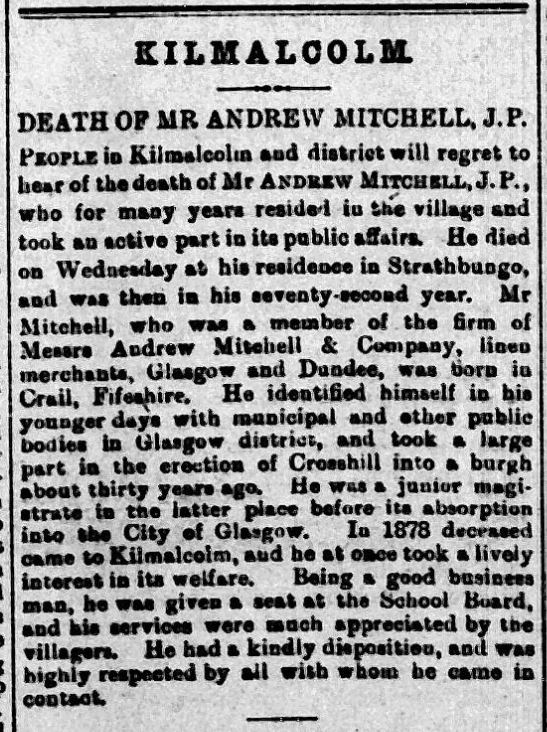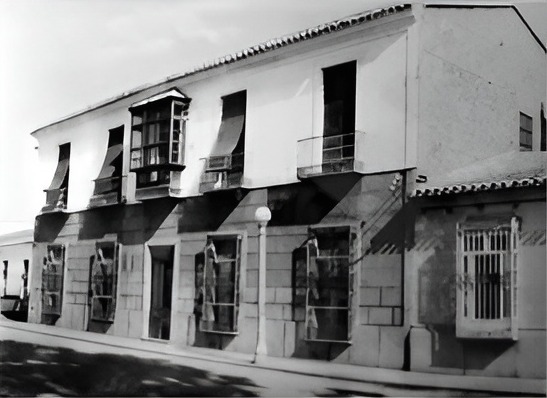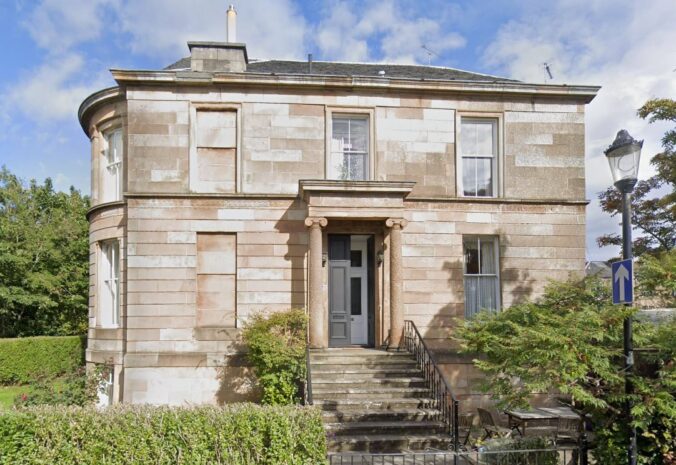52 Marywood Square sits on the corner of Moray Place, and for the first 50 years or so was known as 25 Moray Place, being a part of the third Victorian terrace, 18-25 Moray Place. It only “moved” to Marywood Square when the streets were renumbered around 1929.
John Watson
The first occupant, from 1875, was John Watson, of John Watson & Co, wholesale wine merchants, who moved from Garnethill. He had been born in Lanark, and married Henretta Rogers in Thirsk, Yorkshire in 1866. He had a warehouse at 14 Queen Street (the site was recently Next, now Deichmann, on Argyle & Queen Streets) and he was a regular importer of Geneva (Gin), red and white wine according to the Clyde Bill of Entry and Shipping List.
He suffered from ill health and in February 1877 took a trip to Rothesay with some friends in the hope it would help. He went missing, and his body was later recovered from the sea by a passing yacht. His illness was presumably depression, and his death suicide, though in classic Victorian style, no mention is made of this anywhere .

Account of John’s death, Glasgow Herald 20 Feb 1877. Source: BNA
Soon after, his executors advertised the business for sale, and it was taken over by a Richard Weir who continued it under the same name for some years, later moving to 110 Wellington Street .
The valuation rolls show John’s trustees to be the owners of the house in 1885 and 1895, and his widow Henrietta and his children continued to live there. Henrietta died in 1896 at the still relatively young age of 46.
Andrew Mitchell JP
Andrew Mitchell JP was a linen merchant from Fife, whose firm Andrew Mitchell & Co, linen merchants, saiilcloth and sack manufacturers, had bases in Dundee and Glasgow.
He was born in the village of Crail in 1825 to Andrew Mitchell, mine contractor, and Helen Mitchell nee Fleming. He married Margaret Whimster of Dundee in 1856 in Paisley. Margaret was a widower, having lost her first husband, Richard Robertson, when she was only 27, but already had three young children. With Andrew she had three more. Two step-daughters (Ann & Catherine) and two daughters (Helen & Mary) survived to adulthood.
Andrew built up his business in Glasgow and became involved in public affairs. He was a key figure in the creation of Crosshill Burgh in 1871 and was a junior magistrate there, residing at Crail Villa.
In 1897 he moved to Kilmacolm, and involved himself in local affairs there. In the early 1890s he rented Househill in Nitshill from William Stevenson, quarrymaster and Strathbungo developer and former resident, who had vacated Househill for the mansion that was Hawkhead House. A later tenant, Kate Cranston of the Willow Tea Rooms, made Hous’hill famous by employing Charles Rennie Mackintosh to redesign the interiors.
Andrew appears to have moved in to 25 Moray Place in 1896 after the death of Henrietta Watson. In April 1897 he donated a drinking fountain to his home village of Crail in honour of Queen Victoria’s diamond jubilee. Three hundred medals were cast and given to local schoolchildren to wear at the elaborate ceremony. I wonder if any survive? The drinking fountain itself did survive, and still adorns the village.

Sketch of the new drinking fountain in the Dundee Advertiser, and the fountain today. Source: BNA/Streetview
He didn’t get to enjoy Moray Place for long however; he died there at the age of 72 on 15 September 1897. His wife lived on in the villa at 20 Sutherland Avenue, Pollokshields, a property he had possibly acquired just before he died – the 1897 PO Directory listed it as his address.

Robert M Stirling
Annie Eelbeck (Mitchell) Robertson, Andrew Mitchell’s eldest step-daughter, married Robert Miller Stirling in 1875, and they inherited the house around 1897.
Robert was one of nine children from Kirriemuir where his father James was the minister for 40 years. When James died in 1870 the family left Kirriemuir and moved to Glasgow at 2 Dixon Avenue. Robert worked at John Simpson’s, cabinetmaker and upholsterer, while of his brothers, James became a schoolteacher (possibly classics at Bellahouston), John a house factor and insurance agent and Hugh a solicitor, although William drowned off the coast of Africa in 1874.
The family later moved to Strathbungo, living at 31 (now 23) Regent Park Square. Robert moved out to a flat in East Pollokshields on marrying Annie in 1875. John stayed on, but died young at Regent Park Square in 1877. Hugh later moved away also, probably after their mother died in 1880.
In October 1880 the first advert appears for Robert’s new firm, Stirling & Wylie, both being former employees of the now-deceased John Simpson. Robert had worked for him for 13 years (suggesting he worked for him before moving to Glasgow), and had become experienced as a salesman, cashier and manager, while Wylie was to supervise the manufacturing. They opened premises in Maxwell Street just off the Clyde, and sold under the slightly odd slogan “Small expenses require small profits”, referring to the savings to be had due to their less glamorous location close to St Enoch station. However the partnership was dissolved within a year or two and Robert continued alone. As noted, he moved to 25 Moray Place in 1897.
In 1906 he appeared in the PO Directory as a “wholesale cabinetmaker and upholsterer, steam cabinet and chair works”, with premises at 1-13 Cumberland St. His sons Fergus and James also worked for the firm, but from 1907 the firm vanished. Robert died suddenly at 25 Moray Place in January 1909 shortly before his 60th birthday. His wife rented out 25 Moray Place, and moved to 45 Keir Street.

Image from Robert M Stirling’s catalogue. Source: Glasgowwestaddress.co.uk
Norman MacLean
Next up was Norman MacLean who appeared in the PO Directory in 1910 and 1911, renting 25 Moray Place from Annie Robertson. Also his son appears on Glasgow’s Roll of Honour for the Great War using the same address. Which is odd, as I can find no other link for either of them to that address; in fact, they lived in Spain.
Norman was the son of Duncan MacLean of Keose near Stornoway and Ann McColl of Kilmallie by Fort William. The couple moved to Strathbungo and raised a family of four boys from their flat at 14 Regent Park Terrace (now 848 Pollokshaws Road). Duncan died there in 1908. Brothers Malcolm and Roderick became oil merchants as MacLean Brothers, Malcolm moving to 15 Princes Square (now 32 Marywood Square) and Roderick to 11 Regent Park Terrace (830 Pollokshaws Road). Norman initially entered the carpet trade, then became involved in the import of esparto, a Mediterranean grass used for basket weaving and rope. A major trade with Britain began based on its use in paper mills and ship rigging, centred on the port town of Águilas in southeast Spain, and a large British colony developed there.
In 1892 he married Jessie Stephens of Birkenhead in the Wirral, and the couple moved to Águilas. Norman had already been appointed pro-consul there (assistant to the vice-consul) in 1889. Antonio Hernandez Moreno, a local historian in Águilas, has a full account of the esparto trade, and provides further detail about Norman :
At the beginning of the 20th century, Norman MacColl MacLean, another Scot, born in Glasgow on March 5 1860, had taken over from the last of the principal British esparto merchants in Águilas.
MacLean was married to Jessie Stephens, born in Birkenhead, and he became a very respectable and influential man in local business. He must have arrived in town in the 80’s, since he was designated pro-consul in Águilas on March 21 1889, as an assistant of the vice-consul Thomas Hillary Naftel.
In 1894, when he was 34 years old, MacLean appears in the municipal census as an agent of the esparto trading company M de Levy and Sons, becoming at once president and principal shareholder of Puttfarken & Norman, whose factory and esparto warehouse was located at the Playa del Bol.
At first, MacLean lived in a solitary house, named Miramar, situated at the top of a mountain at the Hornillo Beach. Later, he transferred his residence to the consular office at the Plaza de la Constitución, where most of the children of the marriage were born: Marjorie, Sheila, Kenneth Stephens, Elspeth and Fitzroy Donald.
In 1902, he bought the plots of land between the railway station and the beach, where he built a beautiful house of two levels (one of the few houses of English style which were maintained in good condition in Águilas until a few months ago). The house adjoined his two esparto factories and the warehouses in his ownership, La Constancia and Santa Elena. In front of them there were two little wooden piers from which he carried out the operation of loading esparto into steamships anchored out in the Bahia de Levante. All the buildings were situated at the side of what nowadays is the Club Náutico of Águilas.

View from John MacLean’s home “Miramar” over the harbour of Aguilas. Possibly Mrs MacLean sitting on the wall. It’s all covered in holiday apartments now. Source: Archivo General Region de Murcia

John MacLean’s later house facing the beach at the Paseo de Para, built in 1902. Source: Antonio Hernandez Moreno

Norman’s warehouses and pier on the Bahia de Levante, 1902. That’s the edge of his house on the extreme right. Source: Antonio Hernandez Moreno
The beautiful game
In 1896 the Scots in Águilas set up one of the earliest football teams in Spain, Sporting Club Aguileño, with Norman one of the three main shareholders along with John Gray and George L. Boag. This team was the best of the region during the 1900s, winning all their 26 matches without ever conceding a single goal. The Sporting Club Aguileño disappeared in 1907 partly due to the lack of rivals . Norman’s son Allan, eldest of Norman & Jessie’s eight children born in Águilas in 1893, later played for the team.

Sporting Club Aguileño. I think that’s an eagle on their chests – Aguilas translates as Eagles. Source: Antonia Hernandez Moreno
Later Allan moved to Birkenhead to live with his maternal grandparents and studied at Birkenhead Institute for Boys, then at Glasgow High School. Norman presumably travelled between Spain and Scotland regularly (he, his wife and baby Allan were recorded returning on the RMS Nile from Lisbon in 1895), and may have rented the house at Moray Place as his Glasgow home and for Allan to use while studying – it may have been Allan’s last UK address.
Surprisingly Allan then chose to move to Australia to take up farming, boarding the SS Orsova from Sydney in October 1913. He hadn’t been there long when war broke out in Europe and he immediately enlisted in the Sydney Light Infantry. He saw his first action with the ANZAC forces in the landings at Gallipoli on 5 April 1915, but sadly he didn’t even last the day. He is commemorated at the cemetery in Gallipoli, at the High School of Glasgow and the Strathbungo Roll of Honour.
Norman died in Águilas in 1930 . The football club, now in its fourth incarnation, plays in the Spanish fourth tier.
The Aitkins
In 1915 John Aitken rented the house and the family subsequently owned it by 1920. John was a cotton manufacturer’s agent from Kirkintilloch with an office at 5 St Vincent Place in town. He had four boys and a girl with his wife Marion. William and Thomas worked for their father, but William joined the Cameron Highlanders in WW1 and was killed at the Battle of Loos in 1915.
The Shenkins
Barnet Shenkin was born in Daugavpils, Latvia in 1882, and his wife Freda Monfried in Riga, Latvia in 1892. They both moved to Glasgow, fleeing pogroms at home. They met in Glasgow and married in 1914. They lived at 25 Moray Place (now 52 Marywood Square) from around 1925 to after 1949.

Barnet and Freda Shenkin. Source: Mark Shenken
Barnet was an importer of oriental carpets, at Wolfson & Shenkin, 58 West Regent Street, and later B Shenkin & Co. The firm merged with Mercado in the 1950s, when his son Lennie and Bobby Mercado developed a partnership over a game of bridge . Barnet died in 1950 in Glasgow.
Their son Louis Shenkin was born in Glasgow on 17 January 1917 and was educated at Hutchesons’ Grammar School.
Shenkin then went on to study dentistry before being attracted into the family business, with which he remained for more than 60 years.
He was a leading administrator in bridge for more than a decade as Chairman of the British Bridge League, and an occasional non-playing captain of British teams, and an international bridge player in his own right. In 1949 he was a member of the first Scottish team to reach the final of the Gold Cup, Britain’s premier event, losing only narrowly.
He represented Scotland in the Home Internationals on eight occasions between 1949 and 1963, partnering his brother Lennie. His son, Barnet, represented both Britain and Scotland at bridge, and now lives in the US where he teaches and writes on bridge . In 1976 Louis Shenkin, as chairman of the BBL, presented the trophy for Britain’s leading Invitation Pairs event to the winner, his son. Louis died on 22 April 2003 .
His brother Lennie married Sarah Sar of Newark Drive in 1949 .
The family were prominent members of the Jewish community in Glasgow, in particular Reform Judaism. Louis’ wife, Mamie, wrote a history of the Glasgow Reform Synagogue, 1934-94. Currently based in Newton Mearns, the synagogue was first located in the house at 39 Queen Square in Strathbungo for a few years from 1936, later in Albert Road and briefly Langside Halls, and then at 306 Albert Drive.
The house was renumbered in 1930, resulting in it moving from 25 Moray Place to 52 Princes Square, and then renamed to 52 Marywood Square in 1932. Three addresses in two years, without even moving!
The Lustigs

Yehuda Lustig
The Lustigs were Jewish emigres after the war who lodged with the Shenkins. Their son Yehuda, born at No 52 in 1948, returned to Palestine (by then Israel) and joined the Israeli Defence Forces. He was killed in the Yom Kippur War with Egypt in 1973, but despite this setback turned up almost 40 years later to take part in a Mossad assassination plot of a Hamas leader. The Lustig story is so extraordinary that it has its own article.
Later
Clues about subsequent residents come mainly from newspaper articles.
In 1957 a Mr Manson was advertising for additions to his collection of sporrans, dirks, mulls and Scottish duel pistols. In 1958 Gerald Amerio was fined £5 and his wife admonished after they left their 3-month-old daughter alone in a locked room while they went to the cinema. In 1959 Mrs Dorothy Kirk was resident when her young sister was temporarily blinded when she blew up the gas oven. It is possible the property, like many in downtrodden post-war Strathbungo, had become a boarding house by the time of these stories .
Around 1962 Lim & Olive Motyl acquired the house for £2000 and ran a hotel from the premises. It was often used by long-distance lorry drivers who parked on Darnley Road, and crossed the footbridge that then stood at the top of Marywood Square to reach the hotel [personal communication, Olive Motyl].
References
{3557955:VIFVUYHW};{3557955:AVY5EDYM},{3557955:5B4R6PK9};{3557955:9A8GR94C};{3557955:7ZLLP3SC};{3557955:EEZSYPUL};{3557955:RA4WFG9J};{3557955:DEGY4RHC};{3557955:L942FYCG};{3557955:UT3HHKPG};{3557955:N64RCGYF},{3557955:JV2ZLMAR},{3557955:ZKMBGXF7}
vancouver
asc
0
4923
%7B%22status%22%3A%22success%22%2C%22updateneeded%22%3Afalse%2C%22instance%22%3A%22zotpress-792091c4c6a2ff9faeff940886a1eea3%22%2C%22meta%22%3A%7B%22request_last%22%3A0%2C%22request_next%22%3A0%2C%22used_cache%22%3Atrue%7D%2C%22data%22%3A%5B%7B%22key%22%3A%22DEGY4RHC%22%2C%22library%22%3A%7B%22id%22%3A3557955%7D%2C%22meta%22%3A%7B%22numChildren%22%3A1%7D%2C%22bib%22%3A%22%3Cdiv%20class%3D%5C%22csl-bib-body%5C%22%20style%3D%5C%22line-height%3A%201.35%3B%20%5C%22%3E%5Cn%20%20%3Cdiv%20class%3D%5C%22csl-entry%5C%22%20style%3D%5C%22clear%3A%20left%3B%20%5C%22%3E%5Cn%20%20%20%20%3Cdiv%20class%3D%5C%22csl-left-margin%5C%22%20style%3D%5C%22float%3A%20left%3B%20padding-right%3A%200.5em%3B%20text-align%3A%20right%3B%20width%3A%201em%3B%5C%22%3E1.%3C%5C%2Fdiv%3E%3Cdiv%20class%3D%5C%22csl-right-inline%5C%22%20style%3D%5C%22margin%3A%200%20.4em%200%201.5em%3B%5C%22%3EBarnet%20Shenkin%20%5BInternet%5D.%20%5Bcited%202024%20Dec%2014%5D.%20Available%20from%3A%20%3Ca%20href%3D%27http%3A%5C%2F%5C%2Fwww.shenkinbridge.com%5C%2FDefault.aspx%27%3Ehttp%3A%5C%2F%5C%2Fwww.shenkinbridge.com%5C%2FDefault.aspx%3C%5C%2Fa%3E%3C%5C%2Fdiv%3E%5Cn%20%20%3C%5C%2Fdiv%3E%5Cn%3C%5C%2Fdiv%3E%22%2C%22data%22%3A%7B%22itemType%22%3A%22webpage%22%2C%22title%22%3A%22Barnet%20Shenkin%22%2C%22creators%22%3A%5B%5D%2C%22abstractNote%22%3A%22%22%2C%22date%22%3A%22%22%2C%22url%22%3A%22http%3A%5C%2F%5C%2Fwww.shenkinbridge.com%5C%2FDefault.aspx%22%2C%22language%22%3A%22%22%2C%22collections%22%3A%5B%22CAR6MXPM%22%5D%2C%22dateModified%22%3A%222024-12-14T14%3A32%3A48Z%22%7D%7D%2C%7B%22key%22%3A%22EEZSYPUL%22%2C%22library%22%3A%7B%22id%22%3A3557955%7D%2C%22meta%22%3A%7B%22numChildren%22%3A1%7D%2C%22bib%22%3A%22%3Cdiv%20class%3D%5C%22csl-bib-body%5C%22%20style%3D%5C%22line-height%3A%201.35%3B%20%5C%22%3E%5Cn%20%20%3Cdiv%20class%3D%5C%22csl-entry%5C%22%20style%3D%5C%22clear%3A%20left%3B%20%5C%22%3E%5Cn%20%20%20%20%3Cdiv%20class%3D%5C%22csl-left-margin%5C%22%20style%3D%5C%22float%3A%20left%3B%20padding-right%3A%200.5em%3B%20text-align%3A%20right%3B%20width%3A%201em%3B%5C%22%3E1.%3C%5C%2Fdiv%3E%3Cdiv%20class%3D%5C%22csl-right-inline%5C%22%20style%3D%5C%22margin%3A%200%20.4em%200%201.5em%3B%5C%22%3ENorman%20McColl%20Maclean%20%281860-1930%29%20-%20Find%20a%20Grave...%20%5BInternet%5D.%20%5Bcited%202024%20Dec%2014%5D.%20Available%20from%3A%20%3Ca%20href%3D%27https%3A%5C%2F%5C%2Fwww.findagrave.com%5C%2Fmemorial%5C%2F121166149%5C%2Fnorman_mccoll-maclean%27%3Ehttps%3A%5C%2F%5C%2Fwww.findagrave.com%5C%2Fmemorial%5C%2F121166149%5C%2Fnorman_mccoll-maclean%3C%5C%2Fa%3E%3C%5C%2Fdiv%3E%5Cn%20%20%3C%5C%2Fdiv%3E%5Cn%3C%5C%2Fdiv%3E%22%2C%22data%22%3A%7B%22itemType%22%3A%22webpage%22%2C%22title%22%3A%22Norman%20McColl%20Maclean%20%281860-1930%29%20-%20Find%20a%20Grave...%22%2C%22creators%22%3A%5B%5D%2C%22abstractNote%22%3A%22%22%2C%22date%22%3A%22%22%2C%22url%22%3A%22https%3A%5C%2F%5C%2Fwww.findagrave.com%5C%2Fmemorial%5C%2F121166149%5C%2Fnorman_mccoll-maclean%22%2C%22language%22%3A%22en%22%2C%22collections%22%3A%5B%22CAR6MXPM%22%5D%2C%22dateModified%22%3A%222024-12-14T14%3A22%3A17Z%22%7D%7D%2C%7B%22key%22%3A%22N64RCGYF%22%2C%22library%22%3A%7B%22id%22%3A3557955%7D%2C%22meta%22%3A%7B%22parsedDate%22%3A%221957-06-19%22%2C%22numChildren%22%3A1%7D%2C%22bib%22%3A%22%3Cdiv%20class%3D%5C%22csl-bib-body%5C%22%20style%3D%5C%22line-height%3A%201.35%3B%20%5C%22%3E%5Cn%20%20%3Cdiv%20class%3D%5C%22csl-entry%5C%22%20style%3D%5C%22clear%3A%20left%3B%20%5C%22%3E%5Cn%20%20%20%20%3Cdiv%20class%3D%5C%22csl-left-margin%5C%22%20style%3D%5C%22float%3A%20left%3B%20padding-right%3A%200.5em%3B%20text-align%3A%20right%3B%20width%3A%201em%3B%5C%22%3E1.%3C%5C%2Fdiv%3E%3Cdiv%20class%3D%5C%22csl-right-inline%5C%22%20style%3D%5C%22margin%3A%200%20.4em%200%201.5em%3B%5C%22%3ESporrans%2C%20Dirks%2C%20Mulls%20and%20Scottish%20Duel%20Pistols%20wanted%20by%20collector.%20The%20Scotsman%20%5BInternet%5D.%201957%20Jun%2019%20%5Bcited%202024%20Aug%2028%5D%3B%20Available%20from%3A%20%3Ca%20href%3D%27https%3A%5C%2F%5C%2Fwww.britishnewspaperarchive.co.uk%5C%2Fviewer%5C%2Fbl%5C%2F0000540%5C%2F19570619%5C%2F567%5C%2F0021%27%3Ehttps%3A%5C%2F%5C%2Fwww.britishnewspaperarchive.co.uk%5C%2Fviewer%5C%2Fbl%5C%2F0000540%5C%2F19570619%5C%2F567%5C%2F0021%3C%5C%2Fa%3E%3C%5C%2Fdiv%3E%5Cn%20%20%3C%5C%2Fdiv%3E%5Cn%3C%5C%2Fdiv%3E%22%2C%22data%22%3A%7B%22itemType%22%3A%22newspaperArticle%22%2C%22title%22%3A%22Sporrans%2C%20Dirks%2C%20Mulls%20and%20Scottish%20Duel%20Pistols%20wanted%20by%20collector%22%2C%22creators%22%3A%5B%5D%2C%22abstractNote%22%3A%22%22%2C%22date%22%3A%2219%20Jun%201957%22%2C%22section%22%3A%22%22%2C%22language%22%3A%22%22%2C%22ISSN%22%3A%22%22%2C%22url%22%3A%22https%3A%5C%2F%5C%2Fwww.britishnewspaperarchive.co.uk%5C%2Fviewer%5C%2Fbl%5C%2F0000540%5C%2F19570619%5C%2F567%5C%2F0021%22%2C%22collections%22%3A%5B%22CAR6MXPM%22%5D%2C%22dateModified%22%3A%222024-08-28T10%3A12%3A38Z%22%7D%7D%2C%7B%22key%22%3A%22ZKMBGXF7%22%2C%22library%22%3A%7B%22id%22%3A3557955%7D%2C%22meta%22%3A%7B%22parsedDate%22%3A%221959-10-28%22%2C%22numChildren%22%3A1%7D%2C%22bib%22%3A%22%3Cdiv%20class%3D%5C%22csl-bib-body%5C%22%20style%3D%5C%22line-height%3A%201.35%3B%20%5C%22%3E%5Cn%20%20%3Cdiv%20class%3D%5C%22csl-entry%5C%22%20style%3D%5C%22clear%3A%20left%3B%20%5C%22%3E%5Cn%20%20%20%20%3Cdiv%20class%3D%5C%22csl-left-margin%5C%22%20style%3D%5C%22float%3A%20left%3B%20padding-right%3A%200.5em%3B%20text-align%3A%20right%3B%20width%3A%201em%3B%5C%22%3E1.%3C%5C%2Fdiv%3E%3Cdiv%20class%3D%5C%22csl-right-inline%5C%22%20style%3D%5C%22margin%3A%200%20.4em%200%201.5em%3B%5C%22%3EA%20girl%20is%20%26%23x201C%3Bblinded.%26%23x201D%3B%20Daily%20Record%20%5BInternet%5D.%201959%20Oct%2028%20%5Bcited%202024%20Aug%2028%5D%3B%20Available%20from%3A%20%3Ca%20href%3D%27https%3A%5C%2F%5C%2Fwww.britishnewspaperarchive.co.uk%5C%2Fviewer%5C%2Fbl%5C%2F0003741%5C%2F19591028%5C%2F003%5C%2F0003%27%3Ehttps%3A%5C%2F%5C%2Fwww.britishnewspaperarchive.co.uk%5C%2Fviewer%5C%2Fbl%5C%2F0003741%5C%2F19591028%5C%2F003%5C%2F0003%3C%5C%2Fa%3E%3C%5C%2Fdiv%3E%5Cn%20%20%3C%5C%2Fdiv%3E%5Cn%3C%5C%2Fdiv%3E%22%2C%22data%22%3A%7B%22itemType%22%3A%22newspaperArticle%22%2C%22title%22%3A%22A%20girl%20is%20%5C%22blinded%5C%22%22%2C%22creators%22%3A%5B%5D%2C%22abstractNote%22%3A%22%22%2C%22date%22%3A%2228%20Oct%201959%22%2C%22section%22%3A%22%22%2C%22language%22%3A%22%22%2C%22ISSN%22%3A%22%22%2C%22url%22%3A%22https%3A%5C%2F%5C%2Fwww.britishnewspaperarchive.co.uk%5C%2Fviewer%5C%2Fbl%5C%2F0003741%5C%2F19591028%5C%2F003%5C%2F0003%22%2C%22collections%22%3A%5B%5D%2C%22dateModified%22%3A%222024-08-28T10%3A07%3A51Z%22%7D%7D%2C%7B%22key%22%3A%22JV2ZLMAR%22%2C%22library%22%3A%7B%22id%22%3A3557955%7D%2C%22meta%22%3A%7B%22parsedDate%22%3A%221958-08-16%22%2C%22numChildren%22%3A1%7D%2C%22bib%22%3A%22%3Cdiv%20class%3D%5C%22csl-bib-body%5C%22%20style%3D%5C%22line-height%3A%201.35%3B%20%5C%22%3E%5Cn%20%20%3Cdiv%20class%3D%5C%22csl-entry%5C%22%20style%3D%5C%22clear%3A%20left%3B%20%5C%22%3E%5Cn%20%20%20%20%3Cdiv%20class%3D%5C%22csl-left-margin%5C%22%20style%3D%5C%22float%3A%20left%3B%20padding-right%3A%200.5em%3B%20text-align%3A%20right%3B%20width%3A%201em%3B%5C%22%3E1.%3C%5C%2Fdiv%3E%3Cdiv%20class%3D%5C%22csl-right-inline%5C%22%20style%3D%5C%22margin%3A%200%20.4em%200%201.5em%3B%5C%22%3EBaby%20Locked%20in%20Room.%20The%20Scotsman%20%5BInternet%5D.%201958%20Aug%2016%20%5Bcited%202024%20Aug%2028%5D%3B%20Available%20from%3A%20%3Ca%20href%3D%27https%3A%5C%2F%5C%2Fwww.britishnewspaperarchive.co.uk%5C%2Fviewer%5C%2Fbl%5C%2F0000540%5C%2F19580816%5C%2F127%5C%2F0006%27%3Ehttps%3A%5C%2F%5C%2Fwww.britishnewspaperarchive.co.uk%5C%2Fviewer%5C%2Fbl%5C%2F0000540%5C%2F19580816%5C%2F127%5C%2F0006%3C%5C%2Fa%3E%3C%5C%2Fdiv%3E%5Cn%20%20%3C%5C%2Fdiv%3E%5Cn%3C%5C%2Fdiv%3E%22%2C%22data%22%3A%7B%22itemType%22%3A%22newspaperArticle%22%2C%22title%22%3A%22Baby%20Locked%20in%20Room%22%2C%22creators%22%3A%5B%5D%2C%22abstractNote%22%3A%22%22%2C%22date%22%3A%2216%20Aug%201958%22%2C%22section%22%3A%22%22%2C%22language%22%3A%22%22%2C%22ISSN%22%3A%22%22%2C%22url%22%3A%22https%3A%5C%2F%5C%2Fwww.britishnewspaperarchive.co.uk%5C%2Fviewer%5C%2Fbl%5C%2F0000540%5C%2F19580816%5C%2F127%5C%2F0006%22%2C%22collections%22%3A%5B%5D%2C%22dateModified%22%3A%222024-08-28T10%3A06%3A45Z%22%7D%7D%2C%7B%22key%22%3A%227ZLLP3SC%22%2C%22library%22%3A%7B%22id%22%3A3557955%7D%2C%22meta%22%3A%7B%22parsedDate%22%3A%222023-01-16%22%2C%22numChildren%22%3A1%7D%2C%22bib%22%3A%22%3Cdiv%20class%3D%5C%22csl-bib-body%5C%22%20style%3D%5C%22line-height%3A%201.35%3B%20%5C%22%3E%5Cn%20%20%3Cdiv%20class%3D%5C%22csl-entry%5C%22%20style%3D%5C%22clear%3A%20left%3B%20%5C%22%3E%5Cn%20%20%20%20%3Cdiv%20class%3D%5C%22csl-left-margin%5C%22%20style%3D%5C%22float%3A%20left%3B%20padding-right%3A%200.5em%3B%20text-align%3A%20right%3B%20width%3A%201em%3B%5C%22%3E1.%3C%5C%2Fdiv%3E%3Cdiv%20class%3D%5C%22csl-right-inline%5C%22%20style%3D%5C%22margin%3A%200%20.4em%200%201.5em%3B%5C%22%3E%26%23xC1%3Bguilas%20CF.%20In%3A%20Wikipedia%20%5BInternet%5D.%202023%20%5Bcited%202024%20Aug%2022%5D.%20Available%20from%3A%20%3Ca%20href%3D%27https%3A%5C%2F%5C%2Fen.wikipedia.org%5C%2Fw%5C%2Findex.php%3Ftitle%3D%25C3%2581guilas_CF%26oldid%3D1133951994%27%3Ehttps%3A%5C%2F%5C%2Fen.wikipedia.org%5C%2Fw%5C%2Findex.php%3Ftitle%3D%25C3%2581guilas_CF%26oldid%3D1133951994%3C%5C%2Fa%3E%3C%5C%2Fdiv%3E%5Cn%20%20%3C%5C%2Fdiv%3E%5Cn%3C%5C%2Fdiv%3E%22%2C%22data%22%3A%7B%22itemType%22%3A%22encyclopediaArticle%22%2C%22title%22%3A%22%5Cu00c1guilas%20CF%22%2C%22creators%22%3A%5B%5D%2C%22abstractNote%22%3A%22%5Cu00c1guilas%20Club%20de%20F%5Cu00fatbol%20was%20a%20Spanish%20football%20team%20in%20%5Cu00c1guilas%2C%20in%20the%20autonomous%20community%20of%20Murcia.%20Founded%20in%201925%20and%20dissolved%20in%202010%2C%20it%20played%20its%20last%20season%20%282009%5Cu201310%29%20in%20Segunda%20Divisi%5Cu00f3n%20B%20%5Cu2013%20Group%202%2C%20holding%20home%20games%20at%20Estadio%20El%20Rubial%20with%20a%203%2C000%20seat%20capacity.%22%2C%22encyclopediaTitle%22%3A%22Wikipedia%22%2C%22date%22%3A%222023-01-16T07%3A39%3A20Z%22%2C%22ISBN%22%3A%22%22%2C%22url%22%3A%22https%3A%5C%2F%5C%2Fen.wikipedia.org%5C%2Fw%5C%2Findex.php%3Ftitle%3D%25C3%2581guilas_CF%26oldid%3D1133951994%22%2C%22language%22%3A%22en%22%2C%22collections%22%3A%5B%22CAR6MXPM%22%5D%2C%22dateModified%22%3A%222024-08-22T21%3A13%3A24Z%22%7D%7D%2C%7B%22key%22%3A%229A8GR94C%22%2C%22library%22%3A%7B%22id%22%3A3557955%7D%2C%22meta%22%3A%7B%22numChildren%22%3A1%7D%2C%22bib%22%3A%22%3Cdiv%20class%3D%5C%22csl-bib-body%5C%22%20style%3D%5C%22line-height%3A%201.35%3B%20%5C%22%3E%5Cn%20%20%3Cdiv%20class%3D%5C%22csl-entry%5C%22%20style%3D%5C%22clear%3A%20left%3B%20%5C%22%3E%5Cn%20%20%20%20%3Cdiv%20class%3D%5C%22csl-left-margin%5C%22%20style%3D%5C%22float%3A%20left%3B%20padding-right%3A%200.5em%3B%20text-align%3A%20right%3B%20width%3A%201em%3B%5C%22%3E1.%3C%5C%2Fdiv%3E%3Cdiv%20class%3D%5C%22csl-right-inline%5C%22%20style%3D%5C%22margin%3A%200%20.4em%200%201.5em%3B%5C%22%3EAntonio%20Hernandez%20Moreno%20%5BInternet%5D.%20%5Bcited%202024%20Aug%2022%5D.%20Available%20from%3A%20%3Ca%20href%3D%27http%3A%5C%2F%5C%2Fantoniohernandezmoreno.com%5C%2Faguilasingleses.php%3FIdioma%3Den%27%3Ehttp%3A%5C%2F%5C%2Fantoniohernandezmoreno.com%5C%2Faguilasingleses.php%3FIdioma%3Den%3C%5C%2Fa%3E%3C%5C%2Fdiv%3E%5Cn%20%20%3C%5C%2Fdiv%3E%5Cn%3C%5C%2Fdiv%3E%22%2C%22data%22%3A%7B%22itemType%22%3A%22webpage%22%2C%22title%22%3A%22Antonio%20Hernandez%20Moreno%22%2C%22creators%22%3A%5B%5D%2C%22abstractNote%22%3A%22%22%2C%22date%22%3A%22%22%2C%22url%22%3A%22http%3A%5C%2F%5C%2Fantoniohernandezmoreno.com%5C%2Faguilasingleses.php%3FIdioma%3Den%22%2C%22language%22%3A%22%22%2C%22collections%22%3A%5B%22CAR6MXPM%22%5D%2C%22dateModified%22%3A%222024-08-22T20%3A34%3A44Z%22%7D%7D%2C%7B%22key%22%3A%22AVY5EDYM%22%2C%22library%22%3A%7B%22id%22%3A3557955%7D%2C%22meta%22%3A%7B%22parsedDate%22%3A%221877-03-14%22%2C%22numChildren%22%3A1%7D%2C%22bib%22%3A%22%3Cdiv%20class%3D%5C%22csl-bib-body%5C%22%20style%3D%5C%22line-height%3A%201.35%3B%20%5C%22%3E%5Cn%20%20%3Cdiv%20class%3D%5C%22csl-entry%5C%22%20style%3D%5C%22clear%3A%20left%3B%20%5C%22%3E%5Cn%20%20%20%20%3Cdiv%20class%3D%5C%22csl-left-margin%5C%22%20style%3D%5C%22float%3A%20left%3B%20padding-right%3A%200.5em%3B%20text-align%3A%20right%3B%20width%3A%201em%3B%5C%22%3E1.%3C%5C%2Fdiv%3E%3Cdiv%20class%3D%5C%22csl-right-inline%5C%22%20style%3D%5C%22margin%3A%200%20.4em%200%201.5em%3B%5C%22%3EAdvertisements%20%26amp%3B%20Notices.%20Glasgow%20Herald%20%5BInternet%5D.%201877%20Mar%2014%20%5Bcited%202024%20Aug%2020%5D%3B%20Available%20from%3A%20%3Ca%20href%3D%27https%3A%5C%2F%5C%2Fwww.britishnewspaperarchive.co.uk%5C%2Fviewer%5C%2Fbl%5C%2F0000060%5C%2F18770314%5C%2F004%5C%2F0002%27%3Ehttps%3A%5C%2F%5C%2Fwww.britishnewspaperarchive.co.uk%5C%2Fviewer%5C%2Fbl%5C%2F0000060%5C%2F18770314%5C%2F004%5C%2F0002%3C%5C%2Fa%3E%3C%5C%2Fdiv%3E%5Cn%20%20%3C%5C%2Fdiv%3E%5Cn%3C%5C%2Fdiv%3E%22%2C%22data%22%3A%7B%22itemType%22%3A%22newspaperArticle%22%2C%22title%22%3A%22Advertisements%20%26%20Notices%22%2C%22creators%22%3A%5B%5D%2C%22abstractNote%22%3A%22%22%2C%22date%22%3A%2214%20Mar%201877%22%2C%22section%22%3A%22%22%2C%22language%22%3A%22%22%2C%22ISSN%22%3A%22%22%2C%22url%22%3A%22https%3A%5C%2F%5C%2Fwww.britishnewspaperarchive.co.uk%5C%2Fviewer%5C%2Fbl%5C%2F0000060%5C%2F18770314%5C%2F004%5C%2F0002%22%2C%22collections%22%3A%5B%22CAR6MXPM%22%5D%2C%22dateModified%22%3A%222024-08-20T10%3A42%3A37Z%22%7D%7D%2C%7B%22key%22%3A%22VIFVUYHW%22%2C%22library%22%3A%7B%22id%22%3A3557955%7D%2C%22meta%22%3A%7B%22parsedDate%22%3A%221877-02-20%22%2C%22numChildren%22%3A1%7D%2C%22bib%22%3A%22%3Cdiv%20class%3D%5C%22csl-bib-body%5C%22%20style%3D%5C%22line-height%3A%201.35%3B%20%5C%22%3E%5Cn%20%20%3Cdiv%20class%3D%5C%22csl-entry%5C%22%20style%3D%5C%22clear%3A%20left%3B%20%5C%22%3E%5Cn%20%20%20%20%3Cdiv%20class%3D%5C%22csl-left-margin%5C%22%20style%3D%5C%22float%3A%20left%3B%20padding-right%3A%200.5em%3B%20text-align%3A%20right%3B%20width%3A%201em%3B%5C%22%3E1.%3C%5C%2Fdiv%3E%3Cdiv%20class%3D%5C%22csl-right-inline%5C%22%20style%3D%5C%22margin%3A%200%20.4em%200%201.5em%3B%5C%22%3EA%20Glasgow%20Gentleman%20Drowned%20At%20Rothesay.%20Glasgow%20Herald%20%5BInternet%5D.%201877%20Feb%2020%20%5Bcited%202024%20Aug%2020%5D%3B%20Available%20from%3A%20%3Ca%20href%3D%27https%3A%5C%2F%5C%2Fwww.britishnewspaperarchive.co.uk%5C%2Fviewer%5C%2Fbl%5C%2F0000060%5C%2F18770220%5C%2F028%5C%2F0005%27%3Ehttps%3A%5C%2F%5C%2Fwww.britishnewspaperarchive.co.uk%5C%2Fviewer%5C%2Fbl%5C%2F0000060%5C%2F18770220%5C%2F028%5C%2F0005%3C%5C%2Fa%3E%3C%5C%2Fdiv%3E%5Cn%20%20%3C%5C%2Fdiv%3E%5Cn%3C%5C%2Fdiv%3E%22%2C%22data%22%3A%7B%22itemType%22%3A%22newspaperArticle%22%2C%22title%22%3A%22A%20Glasgow%20Gentleman%20Drowned%20At%20Rothesay%22%2C%22creators%22%3A%5B%5D%2C%22abstractNote%22%3A%22%22%2C%22date%22%3A%2220%20Feb%201877%22%2C%22section%22%3A%22%22%2C%22language%22%3A%22%22%2C%22ISSN%22%3A%22%22%2C%22url%22%3A%22https%3A%5C%2F%5C%2Fwww.britishnewspaperarchive.co.uk%5C%2Fviewer%5C%2Fbl%5C%2F0000060%5C%2F18770220%5C%2F028%5C%2F0005%22%2C%22collections%22%3A%5B%22CAR6MXPM%22%5D%2C%22dateModified%22%3A%222024-08-20T10%3A01%3A28Z%22%7D%7D%2C%7B%22key%22%3A%22UT3HHKPG%22%2C%22library%22%3A%7B%22id%22%3A3557955%7D%2C%22meta%22%3A%7B%22parsedDate%22%3A%221949-07-08%22%2C%22numChildren%22%3A1%7D%2C%22bib%22%3A%22%3Cdiv%20class%3D%5C%22csl-bib-body%5C%22%20style%3D%5C%22line-height%3A%201.35%3B%20%5C%22%3E%5Cn%20%20%3Cdiv%20class%3D%5C%22csl-entry%5C%22%20style%3D%5C%22clear%3A%20left%3B%20%5C%22%3E%5Cn%20%20%20%20%3Cdiv%20class%3D%5C%22csl-left-margin%5C%22%20style%3D%5C%22float%3A%20left%3B%20padding-right%3A%200.5em%3B%20text-align%3A%20right%3B%20width%3A%201em%3B%5C%22%3E1.%3C%5C%2Fdiv%3E%3Cdiv%20class%3D%5C%22csl-right-inline%5C%22%20style%3D%5C%22margin%3A%200%20.4em%200%201.5em%3B%5C%22%3EForthcoming%20marriages.%20Glasgow%20Herald.%201949%20Jul%208%3B%3C%5C%2Fdiv%3E%5Cn%20%20%20%3C%5C%2Fdiv%3E%5Cn%3C%5C%2Fdiv%3E%22%2C%22data%22%3A%7B%22itemType%22%3A%22newspaperArticle%22%2C%22title%22%3A%22Forthcoming%20marriages%22%2C%22creators%22%3A%5B%5D%2C%22abstractNote%22%3A%22%22%2C%22date%22%3A%228%20Jul%201949%22%2C%22section%22%3A%22%22%2C%22language%22%3A%22%22%2C%22ISSN%22%3A%22%22%2C%22url%22%3A%22%22%2C%22collections%22%3A%5B%22CAR6MXPM%22%5D%2C%22dateModified%22%3A%222023-11-09T12%3A45%3A06Z%22%7D%7D%2C%7B%22key%22%3A%225B4R6PK9%22%2C%22library%22%3A%7B%22id%22%3A3557955%7D%2C%22meta%22%3A%7B%22numChildren%22%3A0%7D%2C%22bib%22%3A%22%3Cdiv%20class%3D%5C%22csl-bib-body%5C%22%20style%3D%5C%22line-height%3A%201.35%3B%20%5C%22%3E%5Cn%20%20%3Cdiv%20class%3D%5C%22csl-entry%5C%22%20style%3D%5C%22clear%3A%20left%3B%20%5C%22%3E%5Cn%20%20%20%20%3Cdiv%20class%3D%5C%22csl-left-margin%5C%22%20style%3D%5C%22float%3A%20left%3B%20padding-right%3A%200.5em%3B%20text-align%3A%20right%3B%20width%3A%201em%3B%5C%22%3E1.%3C%5C%2Fdiv%3E%3Cdiv%20class%3D%5C%22csl-right-inline%5C%22%20style%3D%5C%22margin%3A%200%20.4em%200%201.5em%3B%5C%22%3EGlasgow%20Post%20Office%20Directories%20%5BInternet%5D.%20Available%20from%3A%20%3Ca%20href%3D%27https%3A%5C%2F%5C%2Fdigital.nls.uk%5C%2Fdirectories%5C%2Fbrowse%5C%2Farchive%5C%2F91168983%27%3Ehttps%3A%5C%2F%5C%2Fdigital.nls.uk%5C%2Fdirectories%5C%2Fbrowse%5C%2Farchive%5C%2F91168983%3C%5C%2Fa%3E%3C%5C%2Fdiv%3E%5Cn%20%20%3C%5C%2Fdiv%3E%5Cn%3C%5C%2Fdiv%3E%22%2C%22data%22%3A%7B%22itemType%22%3A%22document%22%2C%22title%22%3A%22Glasgow%20Post%20Office%20Directories%22%2C%22creators%22%3A%5B%5D%2C%22abstractNote%22%3A%22%22%2C%22date%22%3A%22%22%2C%22language%22%3A%22%22%2C%22url%22%3A%22https%3A%5C%2F%5C%2Fdigital.nls.uk%5C%2Fdirectories%5C%2Fbrowse%5C%2Farchive%5C%2F91168983%22%2C%22collections%22%3A%5B%22CAR6MXPM%22%5D%2C%22dateModified%22%3A%222022-11-05T14%3A50%3A13Z%22%7D%7D%2C%7B%22key%22%3A%22RA4WFG9J%22%2C%22library%22%3A%7B%22id%22%3A3557955%7D%2C%22meta%22%3A%7B%22numChildren%22%3A1%7D%2C%22bib%22%3A%22%3Cdiv%20class%3D%5C%22csl-bib-body%5C%22%20style%3D%5C%22line-height%3A%201.35%3B%20%5C%22%3E%5Cn%20%20%3Cdiv%20class%3D%5C%22csl-entry%5C%22%20style%3D%5C%22clear%3A%20left%3B%20%5C%22%3E%5Cn%20%20%20%20%3Cdiv%20class%3D%5C%22csl-left-margin%5C%22%20style%3D%5C%22float%3A%20left%3B%20padding-right%3A%200.5em%3B%20text-align%3A%20right%3B%20width%3A%201em%3B%5C%22%3E1.%3C%5C%2Fdiv%3E%3Cdiv%20class%3D%5C%22csl-right-inline%5C%22%20style%3D%5C%22margin%3A%200%20.4em%200%201.5em%3B%5C%22%3EHeraldScotland%20%5BInternet%5D.%20%5Bcited%202020%20Jul%205%5D.%20Celebrating%20expansion%20with%20a%20Lang%20red%20carpet.%20Available%20from%3A%20%3Ca%20href%3D%27https%3A%5C%2F%5C%2Fwww.heraldscotland.com%5C%2Fnews%5C%2F11979036.celebrating-expansion-with-a-lang-red-carpet%5C%2F%27%3Ehttps%3A%5C%2F%5C%2Fwww.heraldscotland.com%5C%2Fnews%5C%2F11979036.celebrating-expansion-with-a-lang-red-carpet%5C%2F%3C%5C%2Fa%3E%3C%5C%2Fdiv%3E%5Cn%20%20%3C%5C%2Fdiv%3E%5Cn%3C%5C%2Fdiv%3E%22%2C%22data%22%3A%7B%22itemType%22%3A%22webpage%22%2C%22title%22%3A%22Celebrating%20expansion%20with%20a%20Lang%20red%20carpet%22%2C%22creators%22%3A%5B%5D%2C%22abstractNote%22%3A%22THESE%20may%20be%20stormy%20times%20for%20Scottish%20Office%20personnel%2C%20but%20Mr%20Ian%22%2C%22date%22%3A%22%22%2C%22url%22%3A%22https%3A%5C%2F%5C%2Fwww.heraldscotland.com%5C%2Fnews%5C%2F11979036.celebrating-expansion-with-a-lang-red-carpet%5C%2F%22%2C%22language%22%3A%22en%22%2C%22collections%22%3A%5B%22CAR6MXPM%22%5D%2C%22dateModified%22%3A%222020-07-05T15%3A09%3A13Z%22%7D%7D%2C%7B%22key%22%3A%22L942FYCG%22%2C%22library%22%3A%7B%22id%22%3A3557955%7D%2C%22meta%22%3A%7B%22parsedDate%22%3A%222003-05-12%22%2C%22numChildren%22%3A1%7D%2C%22bib%22%3A%22%3Cdiv%20class%3D%5C%22csl-bib-body%5C%22%20style%3D%5C%22line-height%3A%201.35%3B%20%5C%22%3E%5Cn%20%20%3Cdiv%20class%3D%5C%22csl-entry%5C%22%20style%3D%5C%22clear%3A%20left%3B%20%5C%22%3E%5Cn%20%20%20%20%3Cdiv%20class%3D%5C%22csl-left-margin%5C%22%20style%3D%5C%22float%3A%20left%3B%20padding-right%3A%200.5em%3B%20text-align%3A%20right%3B%20width%3A%201em%3B%5C%22%3E1.%3C%5C%2Fdiv%3E%3Cdiv%20class%3D%5C%22csl-right-inline%5C%22%20style%3D%5C%22margin%3A%200%20.4em%200%201.5em%3B%5C%22%3ELouis%20Shenkin.%202003%20May%2012%20%5Bcited%202020%20Jul%205%5D%3B%20Available%20from%3A%20%3Ca%20href%3D%27https%3A%5C%2F%5C%2Fwww.telegraph.co.uk%5C%2Fnews%5C%2Fobituaries%5C%2F1429876%5C%2FLouis-Shenkin.html%27%3Ehttps%3A%5C%2F%5C%2Fwww.telegraph.co.uk%5C%2Fnews%5C%2Fobituaries%5C%2F1429876%5C%2FLouis-Shenkin.html%3C%5C%2Fa%3E%3C%5C%2Fdiv%3E%5Cn%20%20%3C%5C%2Fdiv%3E%5Cn%3C%5C%2Fdiv%3E%22%2C%22data%22%3A%7B%22itemType%22%3A%22newspaperArticle%22%2C%22title%22%3A%22Louis%20Shenkin%22%2C%22creators%22%3A%5B%5D%2C%22abstractNote%22%3A%22Chairman%20of%20the%20British%20Bridge%20League%20in%20the%201960s%20who%20refused%20to%20accept%20that%20the%20national%20team%20had%20cheated%22%2C%22date%22%3A%222003-05-12%22%2C%22section%22%3A%22News%22%2C%22language%22%3A%22en-GB%22%2C%22ISSN%22%3A%220307-1235%22%2C%22url%22%3A%22https%3A%5C%2F%5C%2Fwww.telegraph.co.uk%5C%2Fnews%5C%2Fobituaries%5C%2F1429876%5C%2FLouis-Shenkin.html%22%2C%22collections%22%3A%5B%22CAR6MXPM%22%5D%2C%22dateModified%22%3A%222020-07-05T13%3A11%3A19Z%22%7D%7D%5D%7D
1.
Forthcoming marriages. Glasgow Herald. 1949 Jul 8;
Like this:
Like Loading...












December 15, 2024 at 11:11 pm
Colourful history for one house. I hope you make “older bones” than some of your predecessors.
You have mentioned before that the area experienced something of a downturn post war. I wonder why that was and what brought about it’s revival.
December 15, 2024 at 11:22 pm
No one wanted big houses that needed servants post war. Then there was the motorway, and so also the birth of The Strathbungo Society. https://bygone.bungoblog.com/wp/motorway/
December 16, 2024 at 12:04 pm
That is one colourful house history, Andrew – well done!